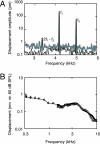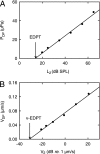Distortion product otoacoustic emissions measured as vibration on the eardrum of human subjects
- PMID: 17242353
- PMCID: PMC1780065
- DOI: 10.1073/pnas.0610185103
Distortion product otoacoustic emissions measured as vibration on the eardrum of human subjects
Abstract
It has previously not been possible to measure eardrum vibration of human subjects in the region of auditory threshold. It is proposed that such measurements should provide information about the status of the mechanical amplifier in the cochlea. It is this amplifier that is responsible for our extraordinary hearing sensitivity. Here, we present results from a laser Doppler vibrometer that we designed to noninvasively probe cochlear mechanics near auditory threshold. This device enables picometer-sized vibration measurements of the human eardrum in vivo. With this sensitivity, we found the eardrum frequency response to be linear down to at least a 20-dB sound pressure level (SPL). Nonlinear cochlear amplification was evaluated with the cubic distortion product of the otoacoustic emissions (DPOAEs) in response to sound stimulation with two tones. DPOAEs originate from mechanical nonlinearity in the cochlea. For stimulus frequencies, f1 and f2, with f2/f1 = 1.2 and f2 = 4-9.5 kHz, and intensities L1 and L2, with L1 = 0.4L(2) + 39 dB and L2 = 20-65 dB SPL, the DPOAE displacement amplitudes were no more than 8 pm across subjects (n = 20), with hearing loss up to 16 dB. DPOAE vibration was nonlinearly dependent on vibration at f2. The dependence allowed the hearing threshold to be estimated objectively with high accuracy; the standard deviation of the threshold estimate was only 8.6 dB SPL. This device promises to be a powerful tool for differentially characterizing the mechanical condition of the cochlea and middle ear with high accuracy.
Conflict of interest statement
The authors declare no conflict of interest.
Figures






References
-
- Lu TK, Zhak S, Dallos P, Sarpeshkar R. Hear Res. 2006;214:45–67. - PubMed
-
- Zwislocki JJ. Auditory Sound Transmission: An Autobiographical Perspective. Mahwah, NJ: Lawrence Erlbaum; 2002.
Publication types
MeSH terms
LinkOut - more resources
Full Text Sources
Other Literature Sources
Miscellaneous

